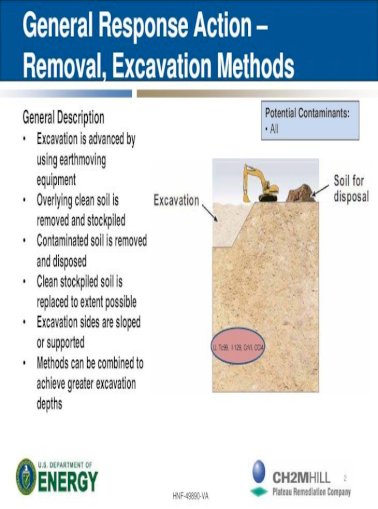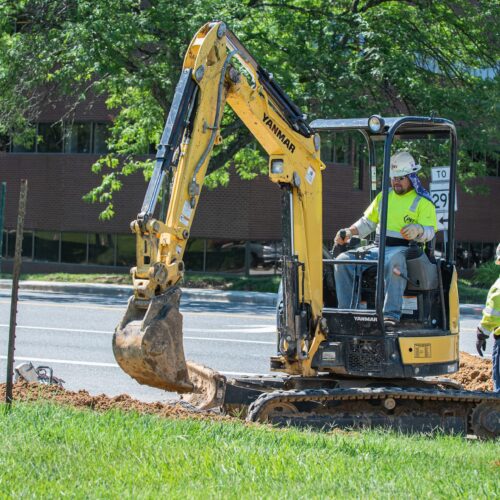The 9-Second Trick For Excavator
Wiki Article
The Main Principles Of Excavation Companies
Table of ContentsGeneral Contractor for DummiesHow Excavating Contractors can Save You Time, Stress, and Money.Rumored Buzz on Excavation Contractors Near MeHow Grading Contractors can Save You Time, Stress, and Money.A Biased View of General Contractor


Scrapers or Pans excavate soil in one place, haul and also dispose the dirt in another place (mini excavator). It is difficult to match the performance of scrapers for cut/fill soil operation if the haul distance is much less after that a mile. Scrapes are generally drawn by a rubber tire wheel tractor and also are occasionally pushed with the cut location by an excavator.
There are numerous times that scrapes are not used for website grading as well as a dump vehicle is used: the haul might be to long, the haul might go across roadways where scrapers are not permitted, difficult rock may be experienced, equipment availability, etc. Discard trucks are in typical use and also most likely require little discussion.
Numerous trucks have a top-hinged tailgate that can not discard any kind of rock broader then the tailgate size. "Rock body" beds, on the various other hand, have no tailgates as well as can unload any kind of dimension rock, although their volume capacity is diminished. These web links show equipment requirements for a number of common dump trucks. Compaction Tools raises the thickness of the soil and also in some situations offers a smooth, rolled surface.
Not known Details About General Contractor
From an easy examination pit to percussion drilling to core boring the proprietor has progressively more expensive choices that produce significantly much better information about the website underground. As an example, the Owner on a 100,000 SF structure project may accredit twenty dull places with split spoon dirt examples taken till rock is gotten to and after that core examples of rock.Knowing the kind and top quality of rock (from the core examples) as well as location of rock (from the soils boring) is an actual advantage in jobsite planning. Conversely, the Owner of a 100,000 SF building might determine to proceed with no geotechnical screening whatsoever. The choice about geotechnical screening is generally made by an Owner without any input from the Construction Manager.
An expertise of the approximate location of the rock aids the Building Supervisor to prepare the series of actions following rock excavation. If rock is in one corner of a large building job, for instance, the earth excavation could begin at the opposite end of the building in order to begin structure job soonest.
Beginning the foundation job early would be a good idea if the rock could be removed by ripping. Nevertheless, if the rock is very tough and also requires significant blasting, it may be prudent to hold structure job up until the blasting is finished. The Construction Supervisor must coordinate these sorts of decisions and also make use of all the technological date offered.
Excavator - The Facts
Unidentified excavation states that all rock or other unexpected products (omitting hazardous materials) experienced in the sitework will be the obligation of the Service provider at no adjustment in agreement price. An unclassified excavation is easier from a book-keeping perspective and also positions the duty for geotechnical conditions onto the Sitework Professional.Exactly How Water Affects Sitework? It's impressive what a hefty rain can do to a construction task. Before the rain, the website may be dry, hefty devices effectively moving earth, the various other trades smoothly doing their job. Within hours the project can be a sloppy, mud-hole with worker effectiveness cut to concerning 10%.
In most locations of the check my reference globe, the Construction Manager have to keep in mind a basic fact: IT WILL RAIN. Excellent planning can lessen the damage as well as disruption of a hefty rain to a jobsite. Usually the excavation as well as grading is entrusted to the Sitework Specialist (and their Foremen is liable to supervise and guide the hefty equipment and also operators).
Consequently the Construction Supervisor need to be constantly knowledgeable about what rainfall will certainly do to the job site. It is not uncommon for the Sitework Foreman to work their hefty tools for optimal effectiveness and also hope it doesn't rainfall. One of the most effective ways to prepare for rainfall is to slope all qualities to drain and to smooth rolled the surface area before a rainfall.
Unknown Facts About Grading Contractors
The Building Manager should be discerning enough to guarantee that hefty rain does not stop work on the job much longer than required. Daily discussions with Sitework Foremen might be called for to attain this objective. Any time excavation is needed listed below the existing water level on a job, the procedure of dewatering must be considered.In an absolutely natural dirt, the water takes a trip so slowly via the clay or silt that dewatering is not typically needed for the fairly short time of excavation. Dewatering may be required for a single footing excavation or for an entire project website. One of the most usual dewatering approaches are trench drains, deep wells as well as well points.

Ground water infiltration can additionally be decreased Our site by cutoff approaches such as sheet piling. The expenses for dewatering can be incredible, including tools service, labor and also power (or fuel). High dewatering costs have faded the earnings margins on far a lot of projects. The many variables listed here make the work of approximating dewatering expenses extremely challenging, as well as very inexact.
This option must constantly be considered when examining the prospect of dewatering. Clearly the alternative is just practical if gravity can run the water to reduced ground. Trench drains pipes can be cut with a backhoe and also loaded with a coarse, granular product (# 4 stone for example), yet treatment needs to be worked out in choosing the water electrical outlet type and also location.
See This Report on Demolition
A siphon, necessarily, makes use of climatic pressure to carry water from one altitude, up over an obstacle, to a lower elevation. The pipes in a siphon system should be closed and some resourcefulness is commonly needed to totally fill up the siphon pipe. The siphon pipe have to be complete for the siphon to start.A deep well contains a pump, tube as well as an upright well casing. The pump intake is at the bottom of the well housing (usually some smashed stone is put there as a filter tool) (grading contractors). The water is pumped up the tube, out of the well housing, and also to an ideal discharge location.
In a crude sand, for example, a large area can be pumped to near the pump intake altitude. A less absorptive soil, on the other hand, decreases the performance of a deep well. Because the pump is typically at the base of the deep well, there are no elevation limitations due to vacuum lift, and deep wells can you can try this out lower the groundwater over 50 feet.
On the bottom of the wellpoint there is a 2 foot long screen and also valve, water jets out of this shutoff and also produces an opening into which the wellpoint pipe can be lowered. This opening is often made a larger diameter (for instance 10 inches) to permit a rugged sand backfill to aid filter the water (concrete contractors).
Report this wiki page